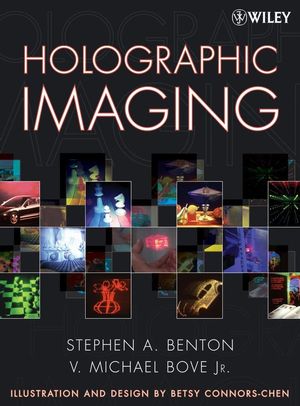Holographic ImagingISBN: 978-0-470-06806-9
Hardcover
296 pages
April 2008
 This is a Print-on-Demand title. It will be printed specifically to fill your order. Please allow an additional 10-15 days delivery time. The book is not returnable.
|
||||||
About this Volume1.
The Window View Upon Reality.
Chapter 1: Holograms and Perception.
Provoking Spatial Perceptions.
Optical Information.
Light as Waves and Rays.
Capturing the Directions of Rays.
Classical Optical Techniques.
Holographic Direction Recording.
Origins of Holography.
Application Areas.
Styles of Analysis.
Chapter 2: Light as Waves.
Light.
Wave Shapes.
Light as Repetitive Waves.
Light as Sinusoidal Waves.
Coherence in Waves.
E&M Nature of the Waves.
Intensity (Irradiance).
Conclusions.
Chapter 3: Waves and Phases.
Introduction.
Wave Phase.
Radius of Curvature.
The Local Inclination and Divergence of a Complex Wave.
Conclusions.
Chapter 4: Two-Beam Interference.
Introduction.
Quantitative Discussion of Interference Contrast.
The Geometry of Interference Fringes.
Simple Interference Patterns.
Conclusions.
Chapter 5: Diffraction.
Introduction.
Diffraction by Periodic Structures.
Single-Slit Diffraction.
The Use of Lenses47.
Viewing Diffraction Patterns With the Eye.
Styles of Diffraction Analysis.
The Grating Equation.
Spatial Frequency.
Grating Example.
Off-Axis Grating Equation.
Diffraction by a Sinusoidal Grating.
Conclusions.
Chapter 6: The Diffraction Efficiency of Gratings.
Introduction.
Definition of Diffraction Efficiency.
Transmission Patterns.
Thick Gratings.
Chapter 7: ‘Platonic’ Holography.
Introduction.
The Object Beam.
The Reference Beam.
The Interference Pattern.
The Holographic Recording Material.
The Holographic Transmittance Pattern.
The Illuminating Beam.
A Proof of Holography.
The Other Reconstructed Components.
Arbitrary Wavefronts.
Diffraction Efficiency.
Conclusions.
Chapter 8: A Ray-Tracing Analysis of Holography.
Introduction.
Mathematical Ray-Tracing.
Numerical Example.
Comparison of Paraxial Hologram and Lens Optics.
Three-Dimensional Ray-Tracing.
Conclusions86.
Chapter 9: Holographic Lenses and In-Line ‘Gabor’ Holography.
Introduction.
Transition to Wavefront Curvature.
Phase Footprints, Again.
In-Line Interference, Again.
Transmittance Proof of the Focus Equation.
In-Line (Gabor) Holograms.
Conclusions.
Chapter 10: Off-Axis ‘Leith & Upatnieks’ Holography.
Introduction.
Implications of Off-Axis Holography.
Interference and Diffraction in Off-Axis Holograms.
Models for Off-Axis Holograms.
Image Magnification.
Intermodulation Noise.
Conclusions.
Chapter 11: Non-Laser Illumination of Holograms.
Introduction.
Problems with Laser Illumination.
Sources of Image Blur.
Narrow-Band Illumination.
Point-Source White Illumination.
Image Depth Effects.
Other Approaches.
Conclusions.
Chapter 12: Phase Conjugation and Real Image Projection.
Real Image Projection Techniques.
Phase Conjugation--a Descriptive Approach.
Perfect Conjugate Illumination (Examples).
Collimator Choices.
Perfect Conjugate Illumination (More Examples).
Effects of Imperfect Conjugates.
Image Location (Analytical).
Image Magnification.
Relation to the Lens and Prism-Pair Model.
Image Aberrations--Astigmatism.
Conclusions.
Chapter 13: Full-Aperture Transfer Holography.
Full-Aperture Transfers.
Further Discussion of H1-H2 Technique.
The Holo-Centric Coordinate System.
Example.
Separate Optimization of the H1 and H2.
Another Point of View: H1 as Multi-Perspective Projector.
View-Zone Edge Effects.
Conclusions.
Chapter 14: White-Light Transmission ‘Rainbow’ Holography.
A Revolution in Holography.
Overview of the Process.
Backwards Analysis.
Slit Width Questions.
Limitations Due to Horizontal-Parallax-Only Imaging.
Conclusions.
Chapter 15: Practical Issues in Rainbow Holography.
Introduction.
Multi-Color Rainbow Holograms.
Multiple-Reference-Beam Holograms.
Multiple-Object-Beam Holograms.
Comparison of the Multi-Color Methods.
Slit-Illumination Beam Forming.
Embossed Holograms.
Shrinkage Compensation.
Conclusions.
Chapter 16: In-line ‘Denisyuk’ Reflection Holography.
Introduction.
Making a Denisyuk Hologram.
The Optics of In-Line Reflection Holograms: Distances.
The Optics of In-Line Reflection Holograms: Angles.
Emulsion Swelling Effects.
Viewing Angle Effects: the ‘Blue Shift’.
Diffraction Efficiency of Reflection Holograms.
Spectrum Width.
Anomalous Spectral Shapes.
Conclusions.
Chapter 17: Off-Axis Reflection Holography.
Introduction.
Qualitative Comparison of Transmission and Reflection Holograms.
Deconstructing Reflection Holograms.
Mathematical Modeling of Reflection Holograms.
Modeling Wavelength Selectivity in Reflection Holography.
Understanding Fringe Geometry.
Changes to the Emulsion.
Modeling Filter Bandwidth.
The ‘Cos-Theta’ Equation.
Conclusions.
Chapter 18: Edge-Lit Holography.
Introduction.
Recording Geometries.
A Practical Issue with Steep Reference Angle Recording.
Characteristics of Recording Within the Inaccessible Zone.
Conclusions.
Chapter 19: Computational Display Holography.
Introduction.
Fourier and Fresnel Holograms.
Computing Fourier Holograms.
Computing Fresnel Holograms.
Full Parallax and Horizontal-Parallax-Only Holograms.
Physically Based Interference Modeling.
Computer Generated Stereogram Modeling.
Diffraction-Specific Modeling: a Hybrid Technique.
A Related Hybrid Technique: Reconfigurable Image Projection (RIP) Holograms.
Toward Interactive, High Quality Displays.
Chapter 20: Holographic Printing.
Holographic Stereograms.
One-Step Approaches.
Holographic Printing.
Conclusions.
Chapter 21: Holographic Television.
The Holy Grail.



